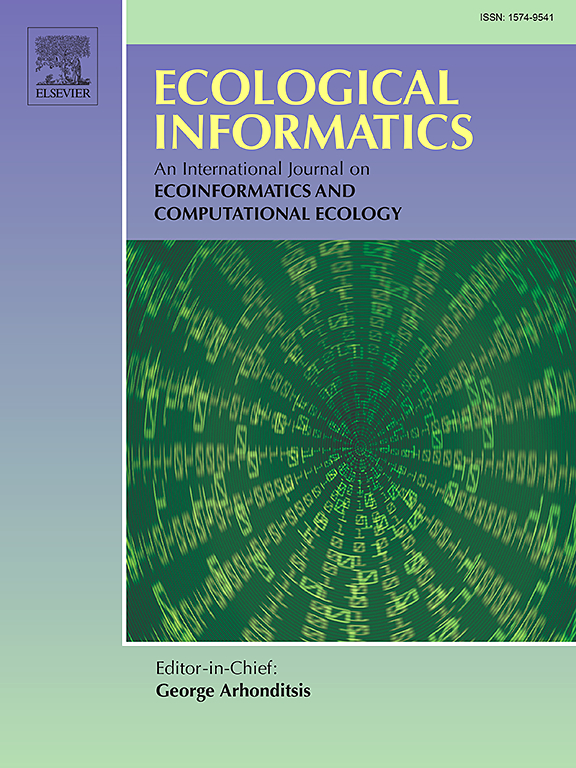Evaluation of a CNN model to map vegetation classification in a subalpine coniferous forest using UAV imagery
IF 5.8
2区 环境科学与生态学
Q1 ECOLOGY
引用次数: 0
Abstract
Unmanned aerial vehicle (UAV) remote sensing based on deep learning has increasingly been applied for forest vegetation classification. However, existing studies have focused mainly on simple woodlands, and accurately mapping the vegetation distribution in complex natural forests remains challenging. To address this, we conducted a study in a natural alpine forest in Southwest China, leveraging high-resolution UAV imagery and deep learning for vegetation classification. We systematically assessed the effects of patch size, spatial resolution, and rotation angle on the model performance, considering their interactions. Our results demonstrate that UAVs combined with deep learning techniques achieve high classification accuracy in natural forests, with a mean F1-score of 0.91. Patch size has a significant influence on accuracy, although its impact diminishes as the spatial resolution decreases. As the patch size increased from 128 × 128 to 256 × 256, the model F1-score improved by 18 % at a 5 cm resolution, whereas it improved by only 3 % at a 10 cm resolution. A higher spatial resolution does not necessarily enhance model accuracy, and the effect of patch size also needs to be considered. The Rotation angle, as a data augmentation strategy, is crucial when training data are limited and can significantly increase model performance. These findings highlight the potential of combining deep learning and UAV remote sensing for natural forests. This approach facilitates more reliable access to forest information in forest areas where access is difficult. Overall, this study provides an efficient and cost-effective method for monitoring and protecting natural forests, serving as a reference for selecting appropriate parameters in UAV-based deep learning remote sensing.
基于无人机图像的亚高山针叶林植被分类CNN模型评价
基于深度学习的无人机遥感技术在森林植被分类中的应用越来越广泛。然而,现有的研究主要集中在简单的林地,准确绘制复杂天然林的植被分布仍然是一个挑战。为了解决这个问题,我们在中国西南的一个天然高山森林中进行了一项研究,利用高分辨率无人机图像和深度学习进行植被分类。我们系统地评估了斑块大小、空间分辨率和旋转角度对模型性能的影响,并考虑了它们之间的相互作用。我们的研究结果表明,无人机与深度学习技术相结合,在天然林中获得了很高的分类精度,平均f1得分为0.91。斑块大小对精度有显著影响,但其影响随着空间分辨率的降低而减小。当斑块大小从128 × 128增加到256 × 256时,模型f1评分在5 cm分辨率下提高了18%,而在10 cm分辨率下仅提高了3%。更高的空间分辨率并不一定能提高模型精度,还需要考虑斑块大小的影响。旋转角度作为一种数据增强策略,在训练数据有限的情况下至关重要,可以显著提高模型的性能。这些发现突出了将深度学习和无人机遥感结合起来用于天然林的潜力。这种方法有助于在难以获得森林信息的林区更可靠地获取森林信息。总体而言,本研究为天然林的监测和保护提供了一种高效、经济的方法,为基于无人机的深度学习遥感选择合适的参数提供了参考。
本文章由计算机程序翻译,如有差异,请以英文原文为准。
求助全文
约1分钟内获得全文
求助全文
来源期刊

Ecological Informatics
环境科学-生态学
CiteScore
8.30
自引率
11.80%
发文量
346
审稿时长
46 days
期刊介绍:
The journal Ecological Informatics is devoted to the publication of high quality, peer-reviewed articles on all aspects of computational ecology, data science and biogeography. The scope of the journal takes into account the data-intensive nature of ecology, the growing capacity of information technology to access, harness and leverage complex data as well as the critical need for informing sustainable management in view of global environmental and climate change.
The nature of the journal is interdisciplinary at the crossover between ecology and informatics. It focuses on novel concepts and techniques for image- and genome-based monitoring and interpretation, sensor- and multimedia-based data acquisition, internet-based data archiving and sharing, data assimilation, modelling and prediction of ecological data.
 求助内容:
求助内容: 应助结果提醒方式:
应助结果提醒方式:


